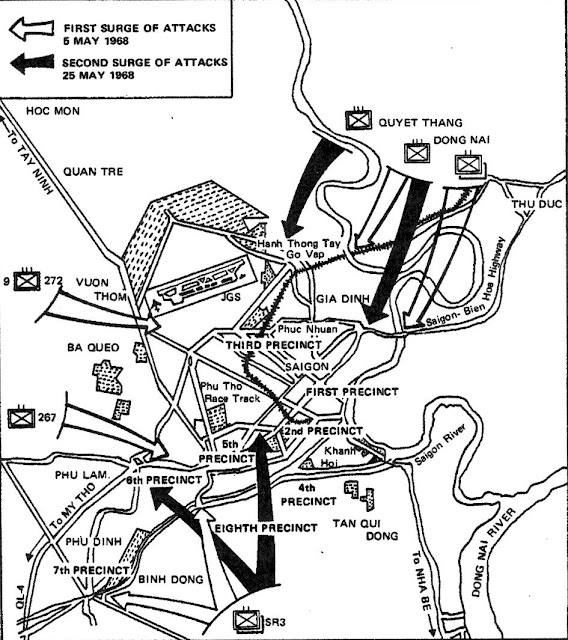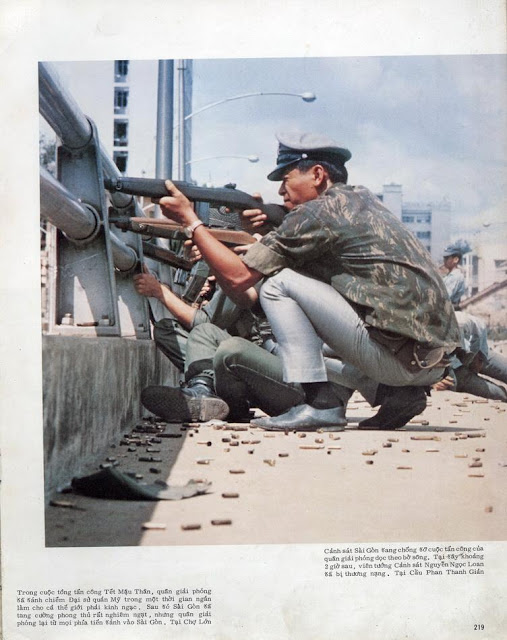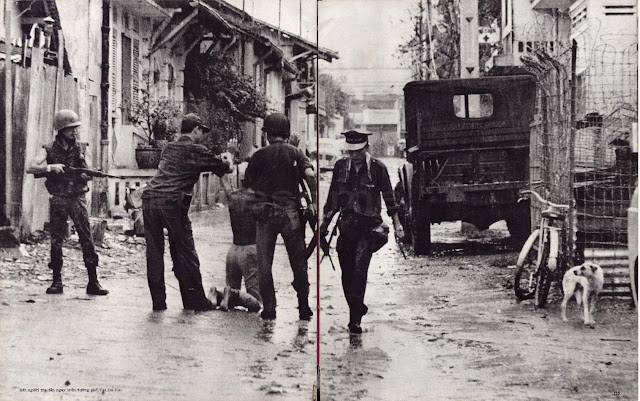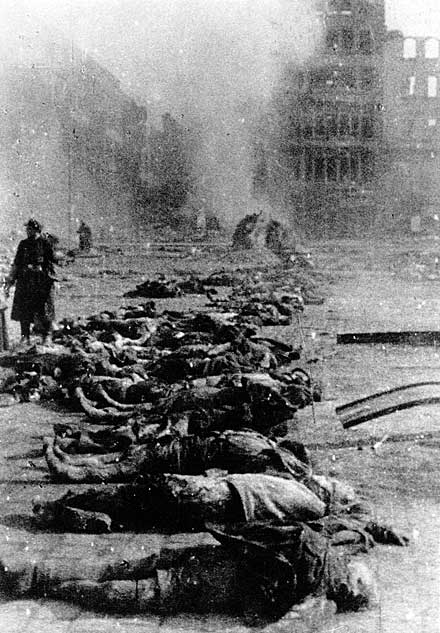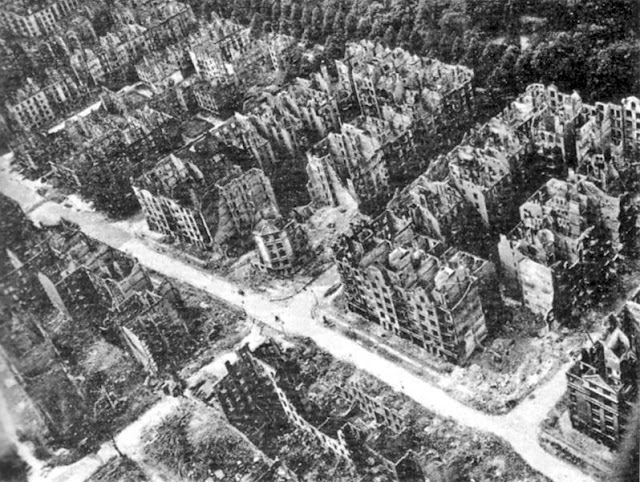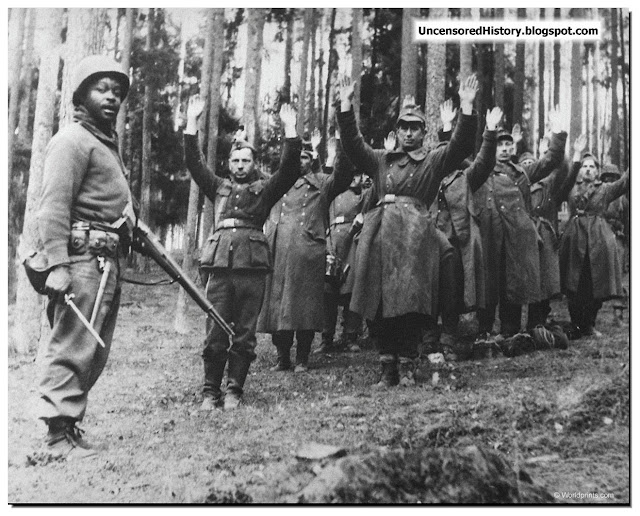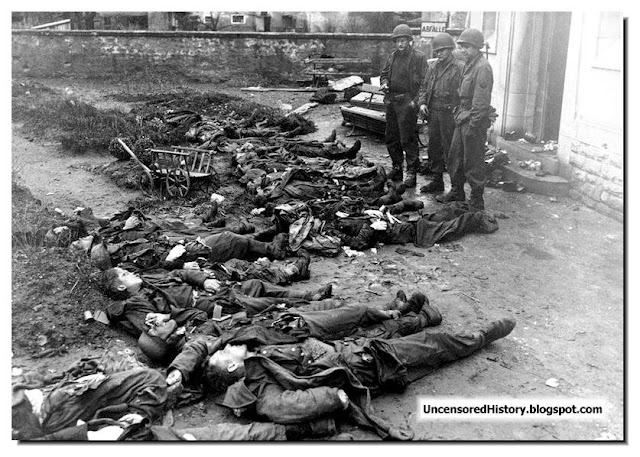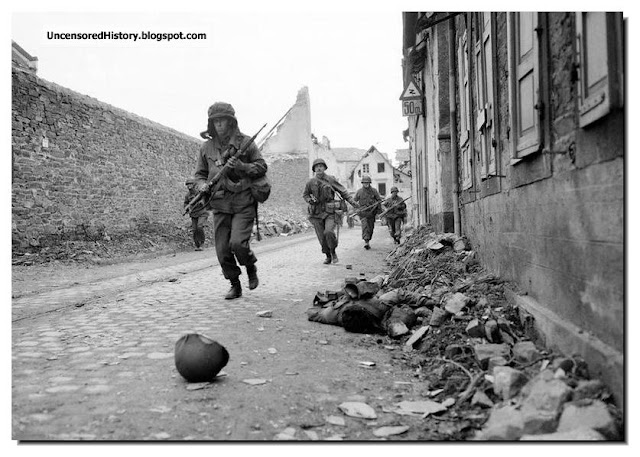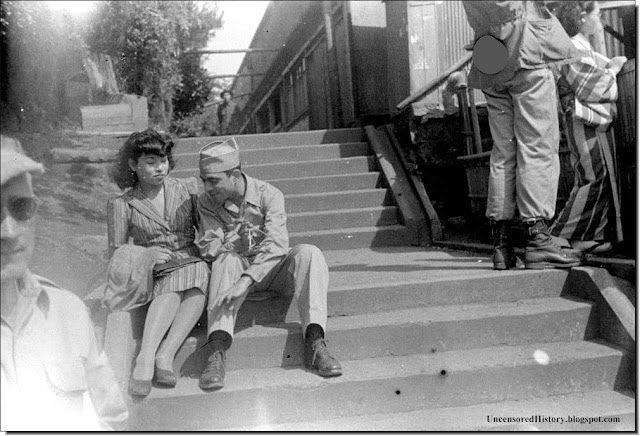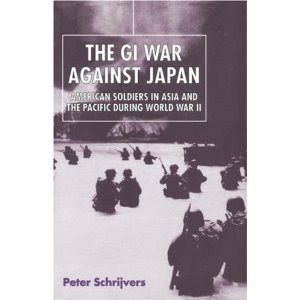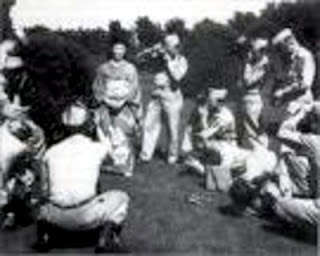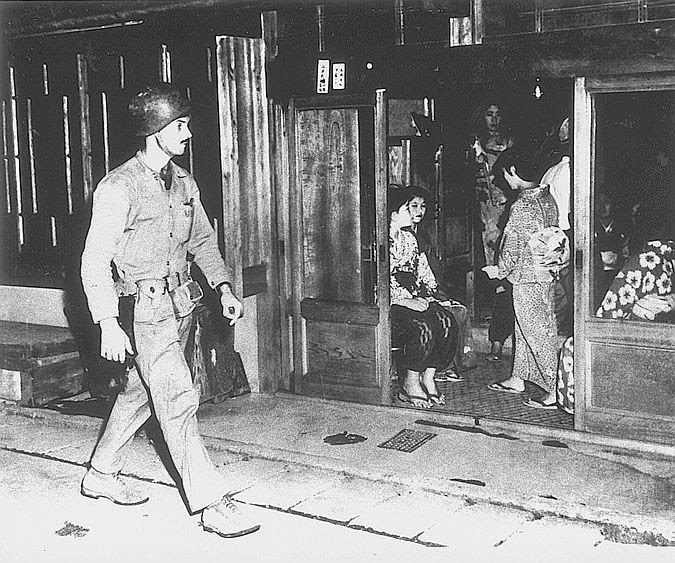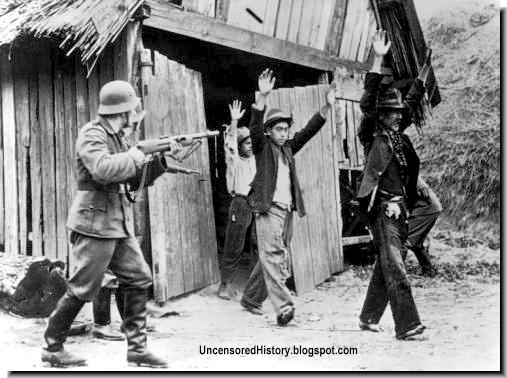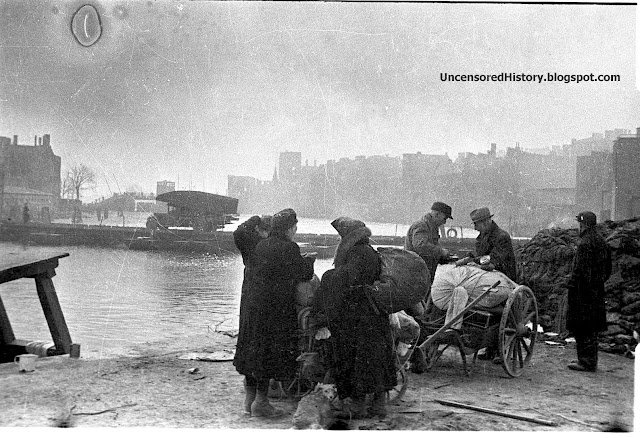It has been established that half of US documented accounts of WW2 are embellished as falsified lies, cover-ups to deviate from the truth of the horrific and despicable War Crimes committed by the US Army which makes them no better then the Nazis, Japanese & Russians.
The National Archives in Washington, (D.C.) contains an official document called the Weekly Prisoner of War and Disarmed Enemy Forces Report for the week ending Sept. 8, 1945. It shows that 1,056,482 German prisoners were being held by the U.S. Army in the European theater, of whom 692,895 were still classified as POWs, and the other 363,587 as DEFs=Disarmed Enemy Forces.
This designation was illegal under international law and completely contrary to the Geneva Convention. In the first week of September 1945, 13,051 of the 363,587 Germans died and were listed cryptically as "Other Losses." At this rate, all remaining 350,536 DEFs would have been dead within 27 weeks before the approaching winter.
-------------------------------
Source US National Archives,
In 1944: Eisenhower told the British ambassador to Washington that the 3,500 officers of the German General staff should be ''exterminated.'' He also favored the liquidation of perhaps 100,000 prominent Germans.
April 17, 1945: The Americans opened their enormous Rheinberg Camp, six miles in circumference, with no food or shelter whatsoever. As in the other big "Rhine meadow" camps, opened in mid-April, there was initially no latrines and no water. In some camps, the men were so crowded they could not lie down. Meanwhile, at Camp Kripp, near Remagen, the half-American Charles von Luttichau determines that his German comrades are receiving about 5% as much food as their captors." Complaining to the camp commander, who stated: ''Forget the Geneva Convention. You don't have any rights."
http://www.canadaatwar.ca/forums/showthread.php?t=2398
Late April 1945: Heinz Janssen, a survivor of the Rheinberg camp, described conditions as they were at the time. "Amputees slithered like amphibians through the mud , soaking and freezing. Naked to the skies day after day and night after flight, they lay desperate in the sand of Rheinberg or sleep exhaustedly into eternity in their collapsing holes.''
Late Summer, 1945: Jean-Pierre Pradervand, head of the International Red Cross delegations in France, told Henry W. Dunning, an American Red Cross official, that conditions in the French camps are worse, in many instances, than anything seen in the former Nazi camps. Pradervand showed Dunning pictures of the living skeletons. Dunning explained all this to the American Red Cross in Washington, which informed key government officials. Nevertheless, the cover-up continued.
1947 - 1950's: Nearly all the surviving records of the Rhineland death camps were destroyed. The West German government concluded that 1.7-million German soldiers were alive at the wars' end, and who were known to have been in fair health, and disappeared. The Western Allies pinned virtually all the blame on the Soviets.
1950: The first German edition of ALLIERTE KRIEGSVERBRECHEN is published. Never translated into English, the book gives eye-witness descriptions of the horrific deplorable conditions which prevailed in the American camps.
MASSACRES BY AMERICAN TROOPS
The Biscari Massacre: which consist of two instances of mass murders, U.S. troops of the 45th Infantry Division killed roughly 75 prisoners of war, mostly Italian.
Source;
-Weingartner, James J. e, NYU Press, 2000, p. 118. ISBN 0814793665
-James J. Weingartner, "Massacre at Biscari: Patton and an American War Crime", Historian, Volume 52 Issue 1, Pages 24–39, 23 Aug 2007
Canicattì Massacre: killing of Italian civilians by Lieutenant Colonel McCaffrey. A confidential inquiry was made, but McCaffrey was never charged with an offence relating to the incident. He died in 1954. This incident remained virtually unknown until Joseph S. Salemi of New York University, whose father witnessed it, publicised it.
Source;
-Giovanni Bartolone, "Le altre stragi: Le stragi alleate e tedesche nella Sicilia del 1943–1944."
-George Duncan: "Massacres and Atrocities of World War II in the Axis Countries."
The Dachau Massacre: killing of German prisoners of war and surrendering SS soldiers at the Dachau concentration camp.
Source; Albert Panebianco (ed). Dachau its liberation 57th Infantry Association, Felix L. Sparks, Secretary 15 June 1989.
Abram Sachar reported, "Some of the Nazis were rounded up and summarily executed along with the guard dogs." According to George Stevens Jr. and Michael Seltzer, 122 SS POWs were killed "in the first hour".
According to Jürgen Zarusky 1997 article in 'Dachauer Hefte', 16 SS men were shot in the coalyard (one more killed by a camp inmate), 17 in Tower B, and perhaps a few more killed by US soldiers in the incident. Anywhere from a few to 25 or 50 more were killed by furious inmates after US Soldiers handed loaded rifles and had guns to the Inmates.
Zarusky's research makes use of the detailed interrogation records contained in Whitaker's official May 1945 investigation report, which became accessible in 1992, as well as a collection of documents compiled by General Henning Linden's son.
In the U.S. military "Investigation of Alleged Mistreatment of German Guards at Dachau" conducted by Lt. Col. Joseph Whitaker, the account given by Col. Howard Buechner, U.S. Army medical officer with 3rd Battalion, 157th Infantry, to Whitaker on 5 May 1945 did not contradict the Sparks account. He state around 16:00 he arrived in the yard where the German soldiers had been shot, and that he "saw 15 or 16 dead and wounded German soldiers lying along the wall." He noted that some of the wounded soldiers were still moving but he did not examine any of them. He further told Whitaker that he did not know the soldier guarding the yard or which company he was from.
Source; Staff. A review of Col. Howard A. Buechner's account of execution of Waffen-SS soldiers during the liberation of Dachau. Scrapbookpages.com, 28 July 2006.
Note Whitaker and Sparks account are falsified numbers, as the picture clearly shows close to 100 SS Guards along that wall.

Col. Felix L. Sparks, a battalion commander of the 157th Infantry Regiment, 45th Infantry Division, Seventh United States Army wrote about the incident. Sparks watched as about 50 German prisoners captured by the 157th Infantry Regiment were confined in an area that had been used for storing coal. The area was partially enclosed by an L-shaped masonry wall about 8 ft (2.4 m) high and next to a hospital. The German POWs were watched over by a machine gun team from Company I. He left those men behind to head towards the center of the camp where there were SS guards who had not yet surrendered; he had only gone a short distance when he heard machine gunfire coming from the area he had just left. He ran back and kicked a 19-year-old soldier who was manning the machine gun and who had killed about 12 of the prisoners and wounded several more. The gunner, who was crying hysterically, said that the prisoners had tried to escape. Sparks said that he doubted the story; Sparks placed an NCO on the gun before resuming his journey towards the center of the camp.
Source; Albert Panebianco (ed). Dachau its liberation 157th Infantry Association, Felix L. Sparks, Secretary 15 June 1989.
The Malmedy Massacre: In the aftermath a written order from the HQ of the 328th US Army Infantry Regiment, dated December 21, 1944, stated: No SS troops or paratroopers will be taken prisoner but will be shot on sight. Major-General Raymond Hufft (U.S. Army) gave instructions to his troops not to take prisoners when they crossed the Rhine in 1945. "After the war, when he reflected on the war crimes he authorized, he admitted, 'if the Germans had won, I would have been on trial at Nuremberg instead of them.'" Stephen Ambrose related: "I've interviewed well over 1000 combat veterans. Only one of them said he shot a prisoner... Perhaps as many as one-third of the veterans...however, related incidents in which they saw other GIs shooting unarmed German prisoners who had their hands up."
Source; Bradley A. Thayer, Darwin and international relations p.186 p.189 p.180
Near the French village of Audouville-la-Hubert 30 German Wehrmacht prisoners were massacred by U.S. paratroopers.
Historian Peter Lieb as Brian Mckenna, ect. Reasearch found that many US and Canadian units were ordered to not take prisoners during the D-Day landings in Normandy. If this view is correct it may explain the fate of 64 German prisoners (out of 130 captured) who did not make it to the POW collecting point on Omaha Beach on D-Day.
According to an article in Der Spiegel by Klaus Wiegrefe, many personal memoirs of Allied soldiers have been willfully ignored by historians until now because they were at odds with the "Greatest Generation" mythology surrounding WWII, but this has recently started to change with books such as "The Day of Battle" by Rick Atkinson where he describes Allied war crimes in Italy, and "D-Day: The Battle for Normandy," by Anthony Beevor. Beevor's latest work is currently discussed by scholars, and should some of them be proven right that means that Allied war crimes in Normandy were much more extensive "than was previously realized".
Source; The Horror of D-Day: A New Openness to Discussing Allied War Crimes in WWII, Spiegel Online, 05/04/2010, (part 1- Part 2).
Operation Teardrop: Eight of the surviving, captured crewmen from the sunk German submarine U-546 are tortured by US military personnel. Historian Philip K. Lundeberg has written that the beating and torture of U-546's survivors was a singular atrocity motivated by the interrogators' need to quickly get information on what the US believed were potential missile attacks on the continental US by German submarines.
Source;
-Lundeberg, Philip K. (1994). "Operation Teardrop Revisited". In Runyan, Timothy J. and Copes, Jan M. To Die Gallantly : The Battle of the Atlantic. Boulder: Westview Press. ISBN 0813388155. , pp. 221–226;
-Blair, Clay (1998). Hitler's U-Boat War. The Hunted, 1942–1945 (Modern Library ed.). New York: Random House. ISBN 0679640339. , p. 687
Atrocities In Sicily 1943
Many massacres of prisoners of war were committed by units of the American 45th Thunderbird Division during the invasion of Sicily in 1943. At Comise airfield, a truck load of German prisoners were machine-gunned as they climbed down on to the tarmac, prior to be air-lifted out. Later the same day, 60 Italian prisoners were cut down the same way. On July 14, 36 prisoners were gunned down near Gela by their guard, US Sergeant Barry West. At Buttera airfield, US Captain Jerry Compton, lined up 43 prisoners against a wall and machine-gunned them to death. West and Compton were both arrested and convicted of murder. They were later sent to the front where both were killed in action. Both had claimed that they were only following orders and quoted General Paton's speech to them earlier, "When we land against the enemy, don't forget to hit him and hit him hard. When we meet the enemy we will kill him. We will show him no mercy. He has killed thousands of your comrades and he must die". On April 29, 1945, units of the 45th Division liberated the concentration camp of Dachau where more atrocities were committed.
When the 45th Division first formed its members wore a red square patch on their left shoulder, inside the patch was a yellow swastika, worne for good Luck. In 1930s, the symbol became slosely associated with German fascist it had to be abandoned as the insigna of the Division.
Source: George Ducan's, Massacres and Atrocities of World War II.
In Butera on July 13,1943 , Darby's Rangers surprised 5 italian soldiers from 34th Regt, Livorno Division loading an artillery piece on a truck. The soldiers surrendered but the US soldiers machine gunned them. Only one survived, Mr Bruno Vagnetti, now 82 years old and recently interviewed by Gianluca di Feo on Corriere della Sera.
In the same area, 2 German and 2 Italian soldiers were killed after they surrendered. It is reported in the memories of Edward Barbarino from Darby's Rangers and confirmed in the book "We Led The Way" from Col Darby (chapter VI - Landing in Sicily). They captured 4 soldiers, they searched them and then Barbarino and 3 US soldiers (Shumstrom, Buie and Passera) shot them.
Sgt. West was court martial, and found guilty for the Biscari Massacre He received a life sentence for killing 37 prisoners of the 75. He never went to jail in the US. He was imprisoned in North Africa and 6 months later sent to the front in Bretagne where he allegedly died, however there's no record.
CHENOGNE Massacer (January 1, 1945)
In the village of Chenogne, a unit of the US 11th Armoured Division had captured around sixty German soldiers. Marched to behind a small hill, out of sight of enemy troops still holding the woods beyond the village, the prisoners were subjected to a volley of machine-gun fire. On this cold and frosty first day of 1945, the GIs were showing no mercy for their unfortunate prisoners as they crumpled to the ground, dead. With memories of the Malmédy massacre still fresh in their minds, killing had become impersonal, revenge was now uppermost in their minds.
Source: George Ducan's, Massacres and Atrocities of World War II.
Some years after the war a mass grave was discovered just west of the city of Nuremberg. In it were the bodies of some 200 SS soldiers. It was not until 1976 that one of the bodies was positively identified. It was the body of SS Hauptsturmfuhrer Kukula, the commander of the 1st Battalion, 38th SS Panzer Grenadier Regiment. Autopsies on the other bodies showed that most had been shot at close range, the others beaten to death by the rifle butts of the US Seventh Army GIs. In the village of Eberstetten, 17 German soldiers of the 'Gotz von Berlichingen' Division were shot after they surrendered to US troops.
On April 8, 1945, fourteen members of the 116th Panzer Division were marched through the streets of Budberg to the command post of the US 95th Infantry Division. There, they were lined up and shot. Three were wounded but managed to escape.
On April 13, 1945, tanks of the US 97th or 78th Infantry Division were approaching the village of Spitze about fifteen miles east of Cologne. They came under fire from a 8.8 anti-tank gun which disabled one of the tanks. That night, the village was pounded by tank and artillery fire and at daybreak the US forces entered the village. All the inhabitants, about eighty, were gathered together in front of the church. Included in the eighty were twenty German soldiers, members of an anti-aircraft unit stationed in the village. They were separated from the civilians and marched several hundred yards to a field just outside the village. There, they were lined up and mowed down by machine-gun fire. Next day the US Army ordered the civilians to dig graves and bury the dead. On April 14, 1995, a memorial for the twenty victims was built near the spot.
During the American assault on Sicily, the largest of the Mediterranean islands, (July, 1943) a dozen unarmed civilians, including some children, were apprehended by US troops after the town of Canicatti surrendered. The civilians were reported to be looting after they had entered a bombed out soap and food factory and were filling buckets with liquid soap that had spilled on the ground. At around 6pm, when an American officer, a lieutenant-colonel, and a group Military Police, accompanied by three interpreters, entered the factory the officer fired a series of shots from his automatic Colt-45 point blank into the crowd. He reloaded and fired again. Eight of the civilians, including an eleven year old girl, died. The officer and soldiers then drove off. Fearing reprisals from the residents of the town, the incident was hushed up for over sixty years. Due to the efforts of Dr. Joseph S. Salemi of New York University, this atrocity was brought to light. The perpetrator of this crime, Lieutenant Colonel McCaffery, died in 1954.

At the village of Chenogne in Belgium a group of twenty-one German soldiers emerged from a burning building carrying a Red Cross flag. Their intention was to surrender to the US forces but as they exited the doorway they were shot down by machine-gun and small arms fire. This happened soon after the Malmedy Massacre on December 17, 1944.
-------------------
Official claims that the death rate of German POWs in American and British hands, were under 1% has been disputed. James Bacque claims an analysis of records supports a German POW death rate of "Over 25%."
Source;
- Dietrich, John (2002). The Morgenthau Plan: Soviet influence on American postwar policy. Pages 131-135: Algora Publishing. ISBN 1892941902.
-James Bacque, Other Losses revised edition 1999, Little Brown and Company, Boston, New York, Toronto, London ISBN 1-55168-191-9
-----------------------
Rheinwiesenlager War crimes Deaths of POWs from starvation and exposure no prosecutions. The Rheinwiesenlager (Rhine meadow camps) were transit camps for millions of German POWs after World War II; there were potentially tens of thousands of deaths from starvation and exposure. Estimates range from just over 3,000 to 71,000.
file added 20040121
Latest minor change 2008/1221
Copyright © 2004 by Hugo S. Cunningham
-------------------------
By James Bacque.
Call it callousness, call it reprisal, call it a policy of hostile neglect: a million Germans taken prisoner by Eisenhower's armies died in captivity after the surrender.
In fact, German prisoners taken by the U.S. Army at the end of the Second World War were denied these and most other rights by a series of specific decisions and directives stemming mainly from SHAEF--Supreme Headquarters, Allied Expeditionary Force. General Dwight Eisenhower was both supreme commander of SHAEF--all the Allied armies in northwest Europe--and the commanding general of the U.S. forces in the European theatre. He was subject to the Combined Chiefs of Staff (CCS) of Britain and the U.S., to the U.S. Joint Chiefs of Staff (JCS), and to the policy of the U.S. government, but in the absence of explicit directives--to the contrary or otherwise--ultimate responsibility for the treatment of the German prisoners in American hands lies with him.
"God , I hate the Germans," Eisenhower wrote to his wife, Mamie, in September, 1944. Earlier, in front of the British ambassador to Washington, he had said that all the 3,500 or so officers of the German General Staff should be "exterminated."
In March, 1945, a message to the Combined Chiefs of Staff signed and initialled by Eisenhower recommended creating a new class of prisoners--Disarmed Enemy Forces, or DEFs--who, unlike Geneva-defined prisoners of war, would not be fed by the army after the surrender of Germany. The message, dated March 10, argues in part: "The additional maintenance commitment entailed by declaring the German Armed Forces prisoners of war which would necessitate the prevision of rations on a scale equal to that of base troops would prove far beyond the capacity of the Allies even if all German sources were tapped."
Respond; "Your approval is requested. Existing plans have been prepared upon this basis."
On April 26, 1945, the Combined Chiefs approved the DEF status for prisoners of war in American hands only: the British members had refused to adopt the American plan for their own prisoners. The Combined Chiefs stipulated that the status of disarmed troops be kept secret.
Eisenhower's quartermaster general at SHAEF, General Robert Littlejohn, had already twice reduced rations for prisoners, and a SHAEF message signed "Eisenhower" had reported to General George Marshall, the U.S. Army Chief of staff, that the prisoner pens would provide "no shelter or other comforts...."









